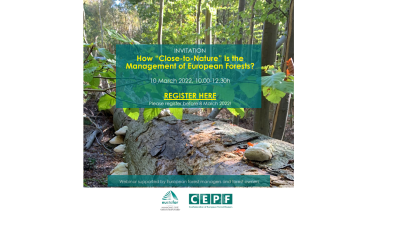Lai veicinātu diskusiju par ES Zaļā kursa, ES Bioloģiskās daudzveidības stratēģijas 2030 ietekmi uz mežu apsaimniekošanu Eiropā, Eiropas privāto meža īpašnieku konfederācijā (CEPF) kopā ar Eiropas valsts mežu apsaimniekotāju asociāciju (EUSTAFOR) organizē tiešsaistes semināru par jaunās apsaimniekošanas pieejas priekšrocībām, mīnusiem un iespējamām sekām Eiropas mežos, š.g., 10. martā plkst. 11:00 (10:00 pēc CET).
Pasākums notiks angļu valodā.
Reģistrācija pasākumam tiešsaistē: https://form.jotform.com/220521908181046
Pasākuma apraksts (ENG)
How "Close-to-Nature" Is the Management of European Forests?
The EU Green Deal, published by the European Commission in late 2019, has significantly shifted the EU approach towards forests and their management. Forests, have been targeted as the main land-use sector to allow the EU to achieve its ambitious 2050 climate and biodiversity related objectives. Forests and forest management in the EU will be strongly influenced through legally-binding proposals such as the EU Fit for 55 Package (revised LULUCF, RED III), Taxonomy, and the upcoming Nature Restoration Law.
At the same time, calls for “closer-to nature” forest management and the strict protection of 10% of EU land, including all remaining primary and old-growth forests, are among the objectives of the EU Biodiversity Strategy for 2030 and the new EU Forest Strategy for 2030. These seem to be ambitious and fargoing while not necessarily building on existing management experiences within the EU.
The current EU policy agenda has assigned climate change mitigation as one of the main roles of EU forests. It is expected from forests to offset GHG emissions from other sectors. Simultaneously, EU forests are expected to fulfill extremely ambitious conservation/protection targets.
Such approaches clearly touch the core functioning of European forests and their management paradigm, with possible drastic changes in the functioning of forestry in the near future.
To contribute to the ongoing discussion, European forest owners and managers would like to support a balanced expert debate on pros, cons and possible consequences of new management approaches for European forests, namely:
1. Options for “closer-to-nature” forest management practices;
2. Active protection or passive conservation – determining which is the best strategy for the future.

